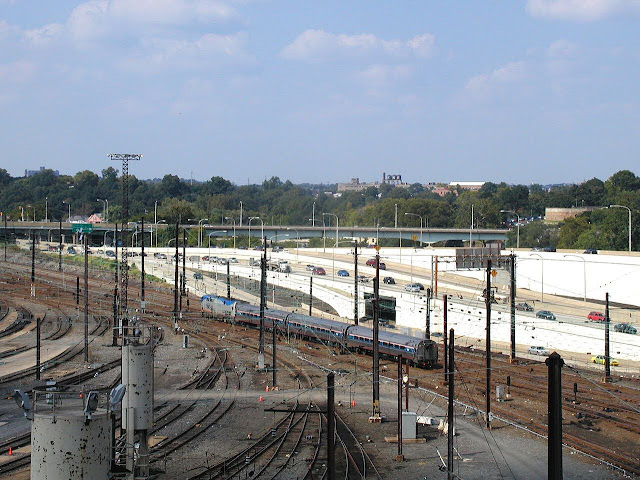Amtrak's 30th Street Station always had a parking deck over the tracks on the north side of the complex, however before 2004 the single level structure was well within the eye line of the booth attendant and any attempt to take photos of the Penn Coach Yards or Amtrak movements would get one shooed away within minutes. Then in 2004 everything changed as a new 8 level parking garage opened on about half the footprint of the old deck to support both 30th St station and the Cira Center office tower built on an adjacent parcel of land. Using a largely self-serve payment process, the cavernous structure had practically no security presence which opened up the world of the north end of the 30th St Station complex to railfan photography. In early fall, 2004, I made my first visit to this parking structure and I am going to share some of the more interesting photos below. For the complete set you can locate them here ( mirror ).
Here we see the 2004 Philly Skyline, which has undergone a drastic transformation in the years since with the addition of numerous high rise residential and office buildings including the Comcast USB sticks.
Over an the approach tracks, MoW orange Amtrak high hood GP10 #770 was towing some road-railers to attach to the Pennsylvanian or Three Rivers. #770 was a former Conrail GP9 that was rebuilt by the Illinois Central Paducah shoppes.
With the collapse of Long Distance trains originating in Philly, Penn Coach Yard is no longer filled to the brim with coaches and Pullman cars, however the Race Street Engine Terminal, both then and now, maintains an eclectic mix of locomotive types at the midpoint of the Northeast Corridor.
In 2004 Amtrak's HHP-8 fleet was only a couple years old and for whatever reason a number of examples including #658 shown here were sitting in Race St with their roof shrouds removed. Also in this photo is Phase III heritage GP40TC #523 and Phase IV heritage P40DC #830.
The GP40TC's were a small fleet of GP40 based passenger diesels obtained from GO Transit when that road upgraded to EMD F59PHs. Here we see #527 in a Phase III heritage scheme next to a fairly new P42DC #165. The GP40TC'swere eventually rebuilt into GP38H-3's that were used for either MoW work or rescuing stranded electric hauled NEC trains due to their head end power capability.
Amtrak GP38-2 #723 is just a basic MoW freight unit with no special passenger capabilities. It is sitting in fromt of NJT ALP-46 #4615 and Amtrak P42DC #11.
The NJT ALP-46's were at Race Street for both corridor testing and to support the Clocker trainsets that were pretty much running as glorified express trains. With the retirement of the E60's, NJT was tapped to provide the motive power. Here we see #4601, #4626 and #4610, sitting near Amtrak P42DC #72 and heritage #830.
In this wider view of the Race St engine servicing facility we can see GP40TC #523, Amtrak GP's 38-2 #720 and #624, HHP-8 #654 (also missing its roof shroud) and high hood GP10 #764 in the background.
The only toaster present that day was Amtrak AEM-7AC #941 waiting to couple onto a Keystone train.
Here is a shot of P42DC #148 backing against a three-car Keystone trainset before it departed on the trip to Harrisburg. It wasn't long before Keystone trains were expanded to 5 cars, however it would be a number of additional years before electric locomotive availability increased and the Harrisburg Line rebuild project fixed the electrification west of Thorndale.
When I eventually returned to Baltimore, I encountered a CSX slot train in the cut on the Baltimore Belt Line between Charles and St. Paul streets with GP40-2 #6354.
The train was digging out the little jungle that had grown up along the tracks in the cut. Drainage issues in this cut would eventually cause the 1890's granite block retaining wall to collapse a decade later after 4 days of heavy rain in April 2014.
Well that's it for this little trip back in time. Hopefully I'll be back to regular content next week.


















No comments:
Post a Comment